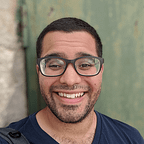WithMe—a clinical trial navigator
design case study
Responsibilities
- Lead design sprint to facilitate understanding
- Design mobile webapp
- Conduct user testing with clickthrough prototype
Deliverables
- User persona
- App design
- Interactive prototype
Timeframe
8 months (October 2016 — June 2017)
1 sentence summary
WithMe is an app that helps overwhelmed cancer patients connect to coordinators who can help them find relevant clinical trials.
Patients + coordinators = 👍
The problem: clinical trial enrollment
Currently (as of 2017), only 3–5% of cancer patients enroll in clinical trials that help bring new cancer therapies to market. This causes long, costly delays in creating safe, new therapies.
One reason for this low enrollment: patients don’t know that these trials even exist! Worse still, the process of finding a research site that offers a specific trial is incredibly complicated. Patients end up confused, and don’t find a trial that fits their needs.
Research
To address the low enrollment problem, our small team of two took a multifaceted approach. (For the curious, we ran a Design Sprint.)
First, we conducted research to gain a shared understanding of the problem. This involved interviewing some subject matter experts and drawing a literal map of the experience. The map illustrates the process of searching for clinical trials: the steps, difficulties, and people involved.
The map of the experience we came up with after interviewing coordinators, nurses, doctors, IT specialists, and UX experts:
After agreeing on our shared understanding of the problem, we conceptualized potential solutions. Lots of white-boarding happened in this step (I ❤ ⬜).
Our research led us down a lot of twisty mental roads, but we ultimately chose to focus on a subset of the general problem: cancer patients very early in their search. They don’t know about trials yet most likely, but they make up ~95% of cancer patients.
Design process
Here’s where the pens and pixels come in. I grabbed my notebook and sketched out some potential ways in which the interaction could play out.
I settled on a Tinder-esque card swiping mechanism for answering simple yes/no questions. I figured swiping cards around would reduce complexity and lower the barrier to entry for patients. And simpler is better when it comes to already-overwhelmed patients.
Next I took to Sketch to design a UI based on that concept:
Later on, user testing revealed that swiping wasn’t nearly as intuitive as I’d believed; several participants struggled with that interaction model. (Also a few folks mentioned the color was too intense for their liking.) Another key bit of feedback was that the app didn’t feel trustworthy; it had no strong identity, nor did it explain to patients upfront how it would help them.
I took much of that feedback into account, and refined the concept into a more traditional lists-and-buttons design (below). I also smoothed out the on-boarding flow to make using the app feel less intrusive. A combination of the new on-boarding, a lighter color palette, and the addition of a logo reduced users’ anxieties about using and trusting the app.
While I was up to my eyeballs in pixels, my partner created the script that we’d follow with people to conduct user testing. We secured four participants and brought them up to speed on a hypothetical patient’s condition and medical history. Through this approach, our participants’ reactions could more closely approximate those of actual cancer patients.
Prototype
Using Marvel, I made a simple clickthrough prototype (limited functionality) from the screens designed in Sketch. I led our participants through scripted in-person user testing, took notes, and recorded the sessions for review later.
Findings & conclusion
Our goal at the outset was to improve the patient experience in clinical trials matching. We believed an app could help accomplish this, and that seems to be true! Additionally, a few findings in particular stood out:
- Patients understand their own conditions better than expected.
- If you’re not careful, interfaces can get in the way of users who want to get to things faster.
4 users is a tiny sample size to be sure, so don’t take this as any kind of assurance. That said, 100% of participants successfully reached the contact-a-coordinator stage of the prototype. This suggests that the interface is usable for the purposes of connecting patients seeking clinical trials and coordinators who can help.
Thanks for reading!
If you enjoyed this, please clap to help others find it more easily.
I’m Juan Valera, a product designer in Seattle, WA. You can see what I’m up to on my personal site and on Twitter!
